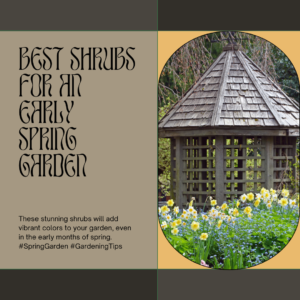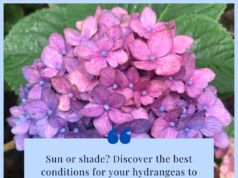
As winter fades away and gives way to spring, it’s time to start thinking about your garden. One way to add color and interest to your early spring garden is by incorporating shrubs. The right shrubs can create a vibrant and stunning display of colors, textures, and blooms.
But with so many options to choose from, it can be challenging to decide which shrubs are best suited for your early spring garden. Fear not! We have compiled a comprehensive guide to help you choose the best shrubs for your spring garden.
Key Takeaways:
- Adding shrubs to your early spring garden can provide color, interest, and attract pollinators.
- Selecting the right shrubs is crucial for a successful and beautiful display.
- Flowering and evergreen shrubs are great options for creating a stunning spring garden.
- Proper planting and care techniques are important for the growth and maintenance of early spring shrubs.
- Skillful design and companion planting can maximize the impact of your shrubs and create visually appealing garden beds.
Benefits of Adding Shrubs to Your Garden
When planning your early spring garden, it’s essential to consider the addition of shrubs. Not only do shrubs provide early colors and interest, but they also bring many benefits to your garden design. Here are some of the reasons why you should consider adding shrubs to your garden:
Early Color and Interest
Shrubs are an excellent choice for early spring gardens since they provide a splash of color and interest long before other plants bloom. These attractive shrubs can add vibrancy to your outdoor space, creating an inviting and refreshing atmosphere.
Attract Pollinators
Many early blooming shrubs are great for attracting pollinators to your garden, such as bees and butterflies. These insects are essential for the reproduction of many plants, making shrubs an excellent addition to your garden ecosystem.
Serve as a Backdrop
Shrubs can also serve as a fantastic backdrop for other plants in your garden. You can use shrubs as a visually appealing backdrop for seasonal annuals and perennials, highlighting their beauty and color.
Low Maintenance
Once established, shrubs require minimal maintenance compared to other plants, making them a perfect choice for those who prefer low maintenance gardening. Many shrubs do not require frequent watering or fertilizer, and some do not require pruning or trimming at all.
Overall, adding shrubs to your early spring garden is an excellent way to bring color, interest and attract pollinators while providing low maintenance and an attractive background for other plants. Choose from a variety of attractive shrubs for early spring, including evergreens, deciduous, and flowering shrubs.
Choosing the Right Shrubs for Early Spring
Selecting the right shrubs for your early spring garden is crucial to ensure a successful and beautiful display. When choosing shrubs, it’s important to consider factors such as your garden’s soil type, sunlight exposure, and climate. You’ll also want to choose shrubs that complement your garden’s overall design and color scheme.
Top Shrubs for Early Spring
When it comes to early spring shrubs, there are many options to choose from. Below are some of the top shrubs recommended by gardening experts:
| Shrub | Bloom Color | Height | Light Needs | Soil Needs |
|---|---|---|---|---|
| Forsythia | Yellow | 6-12 feet | Full sun to partial shade | Well-drained |
| Lilac | Purple, pink, white | 6-12 feet | Full sun | Well-drained, slightly alkaline |
| Magnolia | White, pink, purple | Up to 80 feet | Full sun to partial shade | Well-drained, acidic |
| Daffodil | Yellow, white, orange | 12-18 inches | Full sun to partial shade | Well-drained |
These popular shrubs offer a range of bloom colors, heights, and light and soil needs, making it easy to find the perfect fit for your garden.
Recommended Shrubs for Early Spring Garden
If you’re looking for some additional options, consider one of these recommended shrubs for early spring:
- Spirea
- Redbud
- Flowering quince
- Dogwood
- Camellia
Popular Shrubs for Spring Garden
Other popular shrubs for a spring garden include:
- Azalea
- Rhododendron
- Hydrangea
- Mock orange
- Fothergilla
These shrubs offer a variety of colorful blooms and foliage, adding interest and texture to your garden.
When selecting shrubs for your garden, consider planting a mix of evergreen and deciduous varieties to provide year-round interest. Keep in mind that some shrubs may require pruning to maintain their shape and promote healthy growth. Consult gardening resources or a professional landscaper for advice on selecting and caring for shrubs.
Flowering Shrubs for Early Spring
Early spring is a time of renewal and growth in the garden, and there’s no better way to welcome the season than with flowering shrubs. These versatile plants offer attractive blooms, fragrances, and colors that will enhance your garden’s beauty. Here are some of the best flowering shrubs for early spring:
| Shrub | Bloom Time | Height | Light Needs | Soil Needs |
|---|---|---|---|---|
| Forsythia | Early to mid-spring | 4-8 feet | Full sun to part shade | Well-drained soil |
| Lilac | Mid- to late spring | 5-15 feet | Full sun | Well-drained soil |
| Spirea | Early to mid-spring | 2-6 feet | Full sun to part shade | Moist, well-drained soil |
| Serviceberry | Early spring | 6-20 feet | Full sun to part shade | Moist, well-drained soil |
When selecting flowering shrubs for your early spring garden, consider the bloom time, height, light and soil needs, as well as the shrub’s overall appearance. Forsythia is a popular choice due to its bright yellow blooms and easy care. Lilacs are known for their stunning fragrance and eye-catching flowers. Spirea offers delicate pink or white blooms and graceful arching branches. Serviceberry produces showy white flowers that attract pollinators and colorful berries in the summer.
Be sure to prune your flowering shrubs after they bloom to maintain their shape and promote healthy growth. Deadheading spent blooms can also encourage new growth and prolong the blooming period. With proper care, these flowering shrubs will provide years of beauty and enjoyment in your early spring garden.
Evergreen Shrubs for Early Spring Interest
If you’re looking for shrubs that can provide year-round interest, even in early spring, then evergreens are the way to go. These plants are prized for their attractive foliage and structure, which can enhance the beauty of your garden during this season. Some of the best evergreen shrubs for early spring include:
| Shrub | Description |
|---|---|
| Boxwood (Buxus spp.) | A popular landscape shrub that offers dense green foliage and a classic look. Great as a foundation plant or hedge. |
| Japanese Pieris (Pieris japonica) | A slow-growing shrub with glossy green leaves and clusters of pink or white flowers in early spring. Ideal for woodland gardens. |
| Holly (Ilex spp.) | An iconic shrub with glossy green leaves and striking red berries in winter. Great for hedges or as a specimen plant. |
| Box Honeysuckle (Lonicera nitida) | An evergreen shrub with small, glossy green leaves and fragrant white flowers in early spring. Ideal for low hedges or mass plantings. |
| Andromeda (Pieris japonica) | A compact shrub with narrow, dark green leaves and abundant clusters of white, pink, or red flowers in early spring. Perfect for mixed borders or as a specimen plant. |
These evergreen shrubs not only add interest and structure to your garden but also provide a backdrop for other plants to shine. When selecting evergreens for your early spring garden, look for those with interesting foliage colors or textures that can complement other spring-blooming plants.
As with any shrub, it’s important to provide proper care to ensure their growth and longevity. Evergreens prefer well-draining soil and moderate watering, especially during dry periods. They also benefit from regular pruning to maintain their shape and prevent overcrowding.
Deciduous Shrubs for Spring Garden
Spring is the perfect time to breathe new life into your garden. Adding deciduous shrubs can add texture and dimension to your outdoor space. With so many shrub varieties to choose from, it can be difficult to decide which ones to include in your garden. Here are some great shrub ideas to consider:
1. Lilac (Syringa vulgaris)
Lilacs are a classic choice for any spring garden. Their sweet fragrance and beautiful clusters of flowers will attract bees and butterflies to your yard. Lilacs come in a range of colors, including lavender, pink, and white.
2. Forsythia (Forsythia x intermedia)
Forsythia is a hardy shrub that produces bright yellow flowers early in the season. This shrub is known for its arching branches, which make it a popular choice for borders and hedges.
3. Viburnum (Viburnum spp.)
Viburnums are a versatile group of shrubs that come in various sizes and shapes. They produce clusters of flowers in shades of pink, white, and yellow. Some varieties also produce colorful berries in the fall.
4. Weigela (Weigela florida)
Weigelas are deciduous shrubs that produce tubular flowers in shades of pink, red, and white. They are easy to care for and will attract hummingbirds to your garden.
5. Spirea (Spiraea spp.)
Spireas are a popular choice for their delicate, cascading branches and vibrant flowers. They come in a range of colors, from soft pink to deep red. Some varieties also produce attractive foliage in the fall.
These are just a few of the many deciduous shrubs that will add color and interest to your spring garden. When choosing shrubs, consider their size, shape, and growth habits to ensure they will thrive and complement your garden design.
Planting Shrubs for Early Spring
Proper planting techniques are crucial for ensuring the successful growth and establishment of shrubs in your early spring garden. Follow these step-by-step instructions and top tips for planting shrubs during this season.
1. Choosing the Right Shrubs for Early Spring Planting
When selecting shrubs for early spring planting, it is essential to choose those that can handle the still-cool temperatures of the season. Some of the top shrubs for early spring planting include:
| Shrubs | Growing Conditions |
|---|---|
| Forsythia | Full sun to partial shade; well-draining soil |
| Lilac | Full sun; well-draining soil |
| Spicebush | Full sun to partial shade; moist soil |
| Redbud | Full sun to partial shade; well-draining soil |
These shrubs are hardy, low-maintenance, and offer an abundance of colorful blooms in early spring. They also thrive in the cooler temperatures and shorter days of the season.
2. Timing Your Planting
Timing is crucial when planting shrubs in early spring. Make sure the soil has thawed and is workable before planting. This usually occurs in mid to late March, depending on your location and climate. Avoid planting during periods of extreme cold or wet weather, which can stress the plant and impede growth.
3. Preparing for Planting
Before planting your shrubs, prepare the soil by removing any weeds, rocks, or debris. Dig a hole twice as wide and just as deep as the root ball. Mix in compost or other organic material to improve drainage and provide essential nutrients.
4. Planting Your Shrubs
Place the shrub in the center of the hole and backfill with soil. Tamp the soil gently to remove any air pockets. Water thoroughly to ensure the soil settles and the roots receive adequate moisture.
5. Caring for Your Shrubs
After planting, continue to care for your shrubs to ensure their growth and health. Water regularly, especially during dry spells, and fertilize according to the shrub’s specific needs. Mulching around the base of the plant can help retain moisture and regulate soil temperature.
Pruning is also essential for the proper growth and development of your shrubs. Remove any dead, diseased, or damaged branches in early spring before new growth appears.
By following these planting and care tips, your shrubs will thrive and provide a beautiful display of color and interest in your early spring garden.
Caring for Early Spring Shrubs
After planting your early spring shrubs, it’s essential to care for them properly to ensure their growth and health. Follow these tips to keep your shrubs thriving:
- Water regularly: Spring weather can be unpredictable, so make sure to water your shrubs regularly, especially during periods of drought. Aim to water deeply rather than frequently to encourage deep root growth.
- Fertilize appropriately: Use a slow-release fertilizer in early spring to promote healthy growth. Avoid over-fertilizing, as this can damage the shrub’s roots.
- Prune judiciously: Prune your shrubs after they finish blooming to encourage new growth and maintain their shape. Avoid pruning too much at once, as this can harm the shrub.
- Protect from pests and diseases: Keep an eye out for common pests and diseases that can affect early spring shrubs, such as aphids and powdery mildew. Treat these issues early to prevent further damage.
By following these care tips, you can keep your early spring shrubs healthy and thriving throughout the season.
In early spring, shrubs need plenty of TLC to encourage healthy growth and abundant blooms.
Designing with Shrubs in Mind
When it comes to designing your spring garden, shrubs can play a vital role in creating a visually stunning and functional space. One way to incorporate shrubs into your garden is by using them as a backdrop for other plants.
Consider planting taller shrubs at the back of your garden bed, creating a layered effect that adds depth and interest to the space. You can also use shrubs to define different garden areas or to create a living fence that provides privacy and structure.
Another way to design with shrubs in mind is by selecting varieties with different heights, textures, and colors. This creates a dynamic and visually appealing garden that showcases the beauty of diverse plant life.
Using Color
Color is an important factor to consider when choosing shrubs for your spring garden. Some of the best shrubs for spring bloom include:
- Forsythia
- Lilacs
- Hydrangeas
- Azaleas
- Rhododendrons
When planning your garden design, consider the color and size of your shrubs and how they will complement the other plants in your garden. For example, you can use brightly colored shrubs as a focal point and place them near plants with more subdued colors, creating a stunning contrast.
Shrub Placement
Shrub placement is also crucial to create a harmonious garden design. Place shrubs strategically, so they do not block the view or take up too much space. Also, consider the mature size of the shrub and how much space it will require as it grows.
When planting shrubs, it’s a good idea to position them in groups or clusters to create a more natural and cohesive look. You can also use shrubs to define garden paths and walkways, leading visitors through the space and showcasing the beauty of your garden.
“Designing with shrubs in mind can help you create a beautiful and functional spring garden that showcases the natural beauty of your outdoor space.”
Companion Plants for Early Spring Shrubs
When selecting shrubs for your early spring garden, it’s important to think about companion plants that will complement and enhance their beauty. By choosing the right plants, you can create a harmonious and visually stunning garden bed. Here are some popular companion plants to consider:
1. Daffodils
Daffodils are one of the most popular companion plants for early spring shrubs. Their bright yellow color contrasts beautifully with the pastel shades of many shrub blossoms. Some good shrub options to plant with daffodils include forsythias, lilacs, and cherry laurels.
2. Tulips
Tulips are another excellent choice for companion planting. Their vivid hues add a burst of color to your garden, and they pair well with many early spring shrubs such as viburnums, rhododendrons, and azaleas.
3. Hyacinths
Hyacinths are fragrant flowers that make a perfect match for early spring shrubs. They come in a range of colors, including pink, purple, blue, and white, and can be planted alongside lilacs, dogwoods, and magnolias.
4. Hostas
Hostas are a popular choice for planting beneath early spring shrubs. Their lush foliage contrasts nicely with the delicate blooms of shrubs and provides a textured ground cover. Hostas work well with a variety of shrubs, including azaleas, rhododendrons, and hydrangeas.
5. Bleeding Hearts
Bleeding hearts are a graceful and elegant flower that adds a touch of romance to your garden. Their dangling pink or white flowers look stunning when planted beneath early spring flowering shrubs like lilacs, forsythias, and cherry blossoms.
Remember to consider the growing requirements of both the shrub and companion plant when selecting which ones to plant together. By choosing plants with similar growing needs, you can create a beautiful and thriving garden bed.
Troubleshooting Common Shrubs Issues
While deciduous and evergreen shrubs are hardy and relatively low-maintenance, they may encounter certain problems during their growth. Here are some common issues you may face with your early spring shrubs and how to address them:
Pests and Diseases
Shrubs, like any other plants, can be vulnerable to pests and diseases. Common pests that affect shrubs in early spring include aphids, spider mites, and scale insects. Diseases like powdery mildew and fungal leaf spots can also occur.
To address pest and disease problems, you can use natural remedies such as neem oil or insecticidal soap. For more severe cases, you may need to use chemical treatments. Always read the label and follow instructions carefully when using pesticides.
Yellowing or Wilting Leaves
If you notice yellowing or wilting leaves on your shrubs, it may be a sign of over-watering or under-watering. Check the soil moisture by sticking your finger into the soil. If it feels dry, give your shrubs a good watering. If the soil feels wet, you may be over-watering and causing root rot. Allow the soil to dry out before watering again.
Poor Growth or No Blooms
If your shrubs are not growing well or not blooming, it may be due to poor soil conditions or lack of sunlight. Check the soil pH and nutrient levels and adjust accordingly. If your shrubs are not getting enough sunlight, consider transplanting them to a sunnier location.
Winter Damage
Deciduous shrubs may suffer winter damage, such as broken branches or dieback. If you notice any damage, prune the affected areas to promote new growth. Evergreen shrubs may suffer from winter burn, which is caused by exposure to harsh winter winds and sun. To prevent winter burn, consider wrapping your shrubs with burlap or other protective coverings.
FAQ
What are the best shrubs for an early spring garden?
The best shrubs for an early spring garden include Forsythia, Lilac, Rhododendron, and Viburnum.
What are the benefits of adding shrubs to my garden in early spring?
Adding shrubs to your garden in early spring provides early color and interest, attracts pollinators, and can serve as a backdrop for other garden plants.
How do I choose the right shrubs for my early spring garden?
To choose the right shrubs for your early spring garden, consider factors such as bloom time, size, sunlight requirements, and overall appeal.
Can you recommend some flowering shrubs for early spring?
Sure! Some popular flowering shrubs for early spring include Azalea, Camellia, Magnolia, and Pieris.
Are there any evergreen shrubs that provide interest in early spring?
Absolutely! Some evergreen shrubs that provide interest in early spring include Boxwood, Holly, Juniper, and Yew.
Which deciduous shrubs are recommended for a spring garden?
Recommended deciduous shrubs for a spring garden include Hydrangea, Spirea, Weigela, and Dogwood.
How do I properly plant shrubs in early spring?
To properly plant shrubs in early spring, dig a hole that is slightly wider and deeper than the root ball, place the shrub in the hole, backfill with soil, and water thoroughly.
What care do early spring shrubs require?
Early spring shrubs require regular watering, fertilizing, pruning, and protection from pests and diseases. They also benefit from mulching to conserve moisture.
How can I design my garden with shrubs in mind?
When designing with shrubs in mind, consider their size, shape, and color to create balance and focal points. You can also use shrubs to create borders, hedges, and privacy screens.
What are some good companion plants for early spring shrubs?
Good companion plants for early spring shrubs include perennial flowers like Tulips, Daffodils, and Pansies, as well as groundcovers like Creeping Phlox and Vinca.
What are common issues that early spring shrubs may encounter?
Early spring shrubs may encounter issues such as pest infestations, diseases, poor flowering, and winter damage. Proper care and maintenance can help prevent and address these problems.
How can I ensure a stunning display of colors and blooms in my early spring garden?
By incorporating the best shrubs for your early spring garden and following our guide to selecting, planting, and caring for them, you can create a vibrant and inviting garden for the new season.
Conclusion
Congratulations on exploring the many benefits of adding shrubs to your early spring garden!
In this guide, we have covered the top shrub choices for your early spring garden, discussed the numerous advantages of incorporating shrubs into your garden design, and provided you with a list of top recommended shrubs for this season.
We also talked about different types of shrubs, such as deciduous and evergreens, that are ideal for early spring gardens and provided tips for planting and caring for them.
To maximize the impact of your early spring shrubs, we shared various design ideas for incorporating them into your garden and suggested companion plants that pair well with them. Additionally, we provided solutions to common shrub issues that you may encounter during their growth.
We hope that you found this guide informative and helpful in creating a beautiful and welcoming garden for the new season. With a little planning and care, your early spring shrubs will bring vibrant colors and charming blooms to your outdoor space, creating a refreshing and inviting environment for you and visiting wildlife.
















